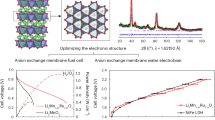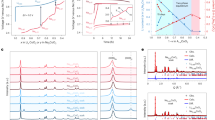Abstract
The fundamental kinetics of the electrocatalytic sulfur reduction reaction (SRR), a complex 16-electron conversion process in lithium–sulfur batteries, is so far insufficiently explored. Here, by directly profiling the activation energies in the multistep SRR, we reveal that the initial reduction of sulfur to the soluble polysulfides is relatively easy owing to the low activation energy, whereas the subsequent conversion of the polysulfides into the insoluble Li2S2/Li2S has a much higher activation energy, contributing to the accumulation of polysulfides and exacerbating the polysulfide shuttling effect. We use heteroatom-doped graphene as a model system to explore electrocatalytic SRR. We show that nitrogen and sulfur dual-doped graphene considerably reduces the activation energy to improve SRR kinetics. Density functional calculations confirm that the doping tunes the p-band centre of the active carbons for an optimal adsorption strength of intermediates and electroactivity. This study establishes electrocatalysis as a promising pathway to tackle the fundamental challenges facing lithium–sulfur batteries.

This is a preview of subscription content, access via your institution
Access options
Access Nature and 54 other Nature Portfolio journals
Get Nature+, our best-value online-access subscription
$29.99 / 30 days
cancel any time
Subscribe to this journal
Receive 12 digital issues and online access to articles
$119.00 per year
only $9.92 per issue
Buy this article
- Purchase on Springer Link
- Instant access to full article PDF
Prices may be subject to local taxes which are calculated during checkout





Similar content being viewed by others
Data availability
The data that support the findings of this study are available from the corresponding authors on reasonable request.
References
Manthiram, A., Fu, Y., Chung, S.-H., Zu, C. & Su, Y.-S. Rechargeable lithium–sulfur batteries. Chem. Rev. 114, 11751–11787 (2014).
Pang, Q., Liang, X., Kwok, C. Y. & Nazar, L. F. Advances in lithium–sulfur batteries based on multifunctional cathodes and electrolytes. Nat. Energy 1, 16132 (2016).
Mikhaylik, Y. V. & Akridge, J. R. Polysulfide shuttle study in the Li/S battery system. J. Electrochem. Soc. 151, A1969–A1976 (2004).
Ma, L., Hendrickson, K. E., Wei, S. & Archer, L. A. Nanomaterials: Science and applications in the lithium–sulfur battery. Nano Today 10, 315–338 (2015).
Seh, Z. W., Sun, Y., Zhang, Q. & Cui, Y. Designing high-energy lithium–sulfur batteries. Chem. Soc. Rev. 45, 5605–5634 (2016).
Bonaccorso, F. et al. Graphene, related two-dimensional crystals, and hybrid systems for energy conversion and storage. Science 347, 1246501 (2015).
Guo, B. et al. Highly dispersed sulfur in a porous aromatic framework as a cathode for lithium–sulfur batteries. Chem. Comm. 49, 4905–4907 (2013).
Li, L. et al. Stabilizing sulfur cathodes using nitrogen-doped graphene as a chemical immobilizer for LiS batteries. Carbon 108, 120–126 (2016).
He, J. et al. Freestanding 1T MoS2/graphene heterostructures as a highly efficient electrocatalyst for lithium polysulfides in Li–S batteries. Energy Environ. Sci. 12, 344–350 (2019).
Peng, L., Zhu, Y., Chen, D., Ruoff, R. S. & Yu, G. Two-dimensional materials for beyond-lithium-ion batteries. Adv. Energy Mater. 6, 1600025 (2016).
Cui, Z., Zu, C., Zhou, W., Manthiram, A. & Goodenough, J. B. Mesoporous titanium nitride-enabled highly stable lithium–sulfur batteries. Adv. Mater. 28, 6926–6931 (2016).
Wang, D. et al. A general atomic surface modification strategy for improving anchoring and electrocatalysis behavior of Ti3C2T2 MXene in lithium–sulfur batteries. ACS Nano 13, 11078–11086 (2019).
Zheng, J. et al. lewis acid–base interactions between polysulfides and metal organic framework in lithium sulfur batteries. Nano Lett. 14, 2345–2352 (2014).
Ji, X. & Nazar, L. F. Advances in Li–S batteries. J. Mater. Chem. 20, 9821–9826 (2010).
Bruce, P. G., Freunberger, S. A., Hardwick, L. J. & Tarascon, J.-M. Li–O2 and Li–S batteries with high energy storage. Nat. Mater. 11, 19–29 (2012).
Du, Z. et al. Cobalt in nitrogen-doped graphene as single-atom catalyst for high-sulfur content lithium–sulfur batteries. J. Am. Chem. Soc. 141, 3977–3985 (2019).
Xu, Z.-L. et al. Exceptional catalytic effects of black phosphorus quantum dots in shuttling-free lithium sulfur batteries. Nat. Commun. 9, 4164 (2018).
Park, J. et al. Tungsten disulfide catalysts supported on a carbon cloth interlayer for high performance Li–S battery. Adv. Energy Mater. 7, 1602567 (2017).
Wild, M. et al. Lithium sulfur batteries, a mechanistic review. Energy Environ. Sci. 8, 3477–3494 (2015).
Barchasz, C. et al. Lithium/sulfur cell discharge mechanism: An original approach for intermediate species identification. Anal. Chem. 84, 3973–3980 (2012).
Wang, L. et al. A quantum-chemical study on the discharge reaction mechanism of lithium-sulfur batteries. J. Energy Chem. 22, 72–77 (2013).
Yin, Y.-X., Xin, S., Guo, Y.-G. & Wan, L.-J. Lithium–sulfur batteries: electrochemistry, materials, and prospects. Angew. Chem. Int. Ed. 52, 13186–13200 (2013).
Tan, G. et al. Burning lithium in CS2 for high-performing compact Li2S–graphene nanocapsules for Li–S batteries. Nat. Energy 2, 17090 (2017).
Sun, H. et al. Three-dimensional holey-graphene/niobia composite architectures for ultrahigh-rate energy storage. Science 356, 599–604 (2017).
Xu, Y. et al. Holey graphene frameworks for highly efficient capacitive energy storage. Nat. Commun. 5, 4554 (2014).
Duan, J., Chen, S., Jaroniec, M. & Qiao, S. Z. Heteroatom-doped graphene-based materials for energy-relevant electrocatalytic processes. ACS Catal. 5, 5207–5234 (2015).
Zhou, H. et al. Understanding defect-stabilized noncovalent functionalization of graphene. Adv. Mater. Interfaces 2, 1500277 (2015).
Wang, X. et al. Heteroatom-doped graphene materials: syntheses, properties and applications. Chem. Soc. Rev. 43, 7067–7098 (2014).
Paulus, U. A., Schmidt, T. J., Gasteiger, H. A. & Behm, R. J. Oxygen reduction on a high-surface area Pt/Vulcan carbon catalyst: a thin-film rotating ring-disk electrode study. J. Electroanal. Chem. 495, 134–145 (2001).
Suen, N.-T. et al. Electrocatalysis for the oxygen evolution reaction: recent development and future perspectives. Chem. Soc. Rev. 46, 337–365 (2017).
Li, M. et al. Single-atom tailoring of platinum nanocatalysts for high-performance multifunctional electrocatalysis. Nat. Catal. 2, 495–503 (2019).
Li, M. et al. Ultrafine jagged platinum nanowires enable ultrahigh mass activity for the oxygen reduction reaction. Science 354, 1414–1419 (2016).
Lu, Y.-C., He, Q. & Gasteiger, H. A. Probing the lithium–sulfur redox reactions: a rotating-ring disk electrode study. J. Phys. Chem. C 118, 5733–5741 (2014).
Zhou, R., Zheng, Y., Jaroniec, M. & Qiao, S.-Z. Determination of the electron transfer number for the oxygen reduction reaction: from theory to experiment. ACS Catal. 6, 4720–4728 (2016).
Bazant, M. Z. Theory of chemical kinetics and charge transfer based on nonequilibrium thermodynamics. Acc. Chem. Res. 46, 1144–1160 (2013).
Ogihara, N. et al. Theoretical and experimental analysis of porous electrodes for lithium-ion batteries by electrochemical impedance spectroscopy using a symmetric cell. J. Electrochem. Soc. 159, A1034–A1039 (2012).
Li, M., Zhang, L., Xu, Q., Niu, J. & Xia, Z. N-doped graphene as catalysts for oxygen reduction and oxygen evolution reactions: Theoretical considerations. J. Catal. 314, 66–72 (2014).
Zhou, G., Paek, E., Hwang, G. S. & Manthiram, A. Long-life Li/polysulphide batteries with high sulphur loading enabled by lightweight three-dimensional nitrogen/sulphur-codoped graphene sponge. Nat. Commun. 6, 7760 (2015).
Ji, Z. et al. Anchoring lithium polysulfides via affinitive interactions: electrostatic attraction, hydrogen bonding, or in parallel? J. Phys. Chem. C 119, 20495–20502 (2015).
Nørskov, J. K. et al. Origin of the overpotential for oxygen reduction at a fuel-cell cathode. J. Phys. Chem. B 108, 17886–17892 (2004).
Hammer, B. & Nørskov, J. K. Why gold is the noblest of all the metals. Nature 376, 238–240 (1995).
Fei, H. et al. Single atom electrocatalysts supported on graphene or graphene-like carbons. Chem. Soc. Rev. 48, 5207–5241 (2019).
Wang, D. & Astruc, D. The recent development of efficient earth-abundant transition-metal nanocatalysts. Chem. Soc. Rev. 46, 816–854 (2017).
Xu, Y., Sheng, K., Li, C. & Shi, G. Self-assembled graphene hydrogel via a one-step hydrothermal process. ACS Nano 4, 4324–4330 (2010).
Fei, H. et al. General synthesis and definitive structural identification of MN4C4 single-atom catalysts with tunable electrocatalytic activities. Nat. Catal. 1, 63–72 (2018).
Kohn, W. & Sham, L. J. Self-consistent equations including exchange and correlation effects. Phys. Rev. 140, A1133–A1138 (1965).
Kresse, G. & Hafner, J. Ab initio molecular dynamics for liquid metals. Phys. Rev. B 47, 558–561 (1993).
Perdew, J. P., Burke, K. & Ernzerhof, M. Generalized gradient approximation made simple. Phys. Rev. Lett. 77, 3865–3868 (1996).
Steinmann, S. N. & Corminboeuf, C. Comprehensive benchmarking of a density-dependent dispersion correction. J. Chem. Theory Comput. 7, 3567–3577 (2011).
Steinmann, S. N. & Corminboeuf, C. A generalized-gradient approximation exchange hole model for dispersion coefficients. J. Chem. Phys. 134, 044117 (2011).
Mathew, K., Sundararaman, R., Letchworth-Weaver, K., Arias, T. A. & Hennig, R. G. Implicit solvation model for density-functional study of nanocrystal surfaces and reaction pathways. J. Chem. Phys. 140, 084106 (2014).
Towns, J. et al. XSEDE: accelerating scientific discovery. Comput. Sci. Eng. 16, 62–74 (2014).
Acknowledgements
This work is supported by the Center for Synthetic Control Across Length-scales for Advancing Rechargeables, an Energy Frontier Research Center funded by the US Department of Energy, Office of Science Basic Energy Sciences programme under award DE-SC0019381. Y.H. acknowledges the support by Office of Naval Research through grant no. N00010141712608 (initial effort on catalyst preparation and rotating disc electrode electrochemical characterizations). I.M. and Z.A. acknowledge the support by the International Scientific Partnership Program (ISPP-147) at King Saud University. We acknowledge the Electron Imaging Center at UCLA for SEM technical support and the Nanoelectronics Research Facility at UCLA for device fabrication technical support. We thank Diamond Light Source for access and support in use of the electron Physical Science Imaging Centre (MG23956). The calculations were performed on the Hoffman2 cluster at UCLA Institute for Digital Research and Education (IDRE), The National Energy Research Scientific Computing Center (NERSC), and the Extreme Science and Engineering Discovery Environment (XSEDE)52, which is supported by National Science Foundation grant number ACI-1548562, through allocation TG-CHE170060.
Author information
Authors and Affiliations
Contributions
X.D., Y.H. and L.P. conceived and designed the experimental research. P.S. and Z.W. designed and performed the DFT calculations. L.P. performed the experiments and conducted the data analysis with contributions from C.W., J.L., Z.C., D.Z., D.B., H.L., X.X., I.S., Z.A., S.T., B.D., Y.H. and X.D. C.S.A. and A.I.K. contributed to the TEM characterizations. All authors discussed the results and commented on the manuscript.
Corresponding authors
Ethics declarations
Competing interests
The authors declare no competing interests.
Additional information
Publisher’s note Springer Nature remains neutral with regard to jurisdictional claims in published maps and institutional affiliations.
Supplementary information
Supplementary Information
Supplementary Figs. 1–14, Discussion, and Tables 1 and 2.
Supplementary Data
Atomic coordinates of the optimized computational models.
Rights and permissions
About this article
Cite this article
Peng, L., Wei, Z., Wan, C. et al. A fundamental look at electrocatalytic sulfur reduction reaction. Nat Catal 3, 762–770 (2020). https://doi.org/10.1038/s41929-020-0498-x
Received:
Accepted:
Published:
Issue Date:
DOI: https://doi.org/10.1038/s41929-020-0498-x
This article is cited by
-
Establishing reaction networks in the 16-electron sulfur reduction reaction
Nature (2024)
-
Developing high-power Li||S batteries via transition metal/carbon nanocomposite electrocatalyst engineering
Nature Nanotechnology (2024)
-
Li2ZnTi3O8 as the host-separator modifier with efficient polysulfides trapping and fast Li+ diffusion for lithium-sulfur batteries
Nano Research (2024)
-
Quantum Spin Exchange Interactions to Accelerate the Redox Kinetics in Li–S Batteries
Nano-Micro Letters (2024)
-
From non-carbon host toward carbon-free lithium-sulfur batteries
Nano Research (2024)



